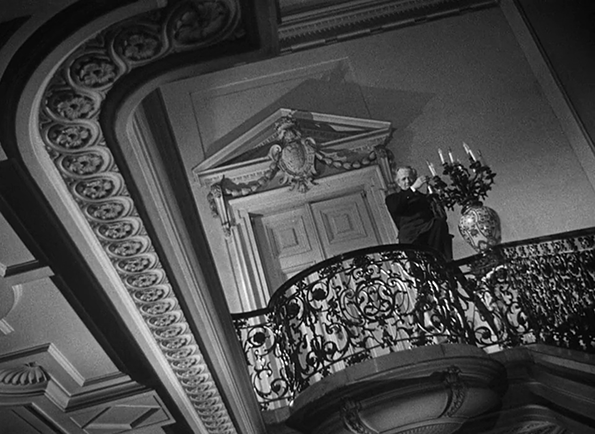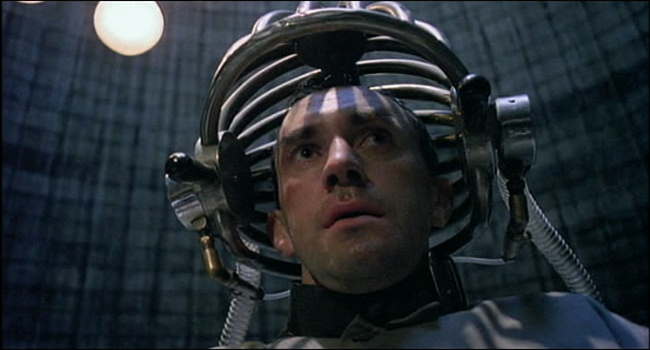Film It Slant
Dutch angles and male vanity in “The Third Man.”
BY DAN DEWEESE
[From the winter 2016 issue.]
POST-WAR VIENNA is crooked—or that, at least, is how Carol Reed photographs it in The Third Man. Reed’s use of Dutch angles is so pervasive in the film that William Wyler, after seeing it, apparently mailed Reed a level and a note with a suggestion for Reed to use it on his next film. (Another version has the film’s crew itself giving him the level.) Whether Reed brought the level to the set of Outcast on the Islands is less important than recognizing that the gift, regardless of who it was from, was a joke only, since a level Third Man would never have worked. The whole point is that something is off.
It’s only the audience, of course, that gets to see the true depth of the crookedness. Over opening documentary footage, a British voice tells us that Holly Martins arrived in post-war Vienna to meet his old friend, Harry Lime. The current Wikipedia entry on The Third Man claims Reed himself handled the narration, but this is wrong, and an important error. (The film’s original U.S. release apparently substituted opening narration by Joseph Cotten. The choice indicates not only a misunderstanding of the film, but also a misunderstanding of American moviegoers, for whom Anglophilia and a love of British accents has always run deep.) Having Trevor Howard read the opening narration suggests the consciousness behind the story is that of Major Calloway, not Holly Martins. We are invited into the story, then, by the voice of a character we will see watch the main character from a cool distance—just as we are about to. It’s the first of Reed’s many subtle subversions of identification in the film.
Joseph Cotten plays Martins eager and earnest, getting off the train, heading to the address he’s been given, and knocking at a door within. As Holly is looking at the door, though, we see this:
Odd angles are one of the features The Third Man is remembered for (along with the participation of Orson Welles, though perhaps that can be considered just another kind of odd angle), but what’s remarkable is how Reed uses them to set up a visual equivalent of dramatic irony, the old trick in which the audience knows more than the character. The Hitchcock version of this is to show the audience something in the world of the film—a bomb, a bad guy, a massive Oedipal conflict—that the protagonist hasn’t seen. Reed’s version is just to tilt the camera so the audience sees a crooked moment that Holly does not.
Dutch angles continue throughout the film. Frames are off counterclockwise so that their contents lean right, then clockwise so the contents lean left. There’s a feeling in these shots of being at sea, and films of boats in storms or airplanes in turbulence (or the Starship Enterprise once per episode) do routinely use the device of rocking the camera. A canted or Dutch angle is in some ways just a frame that has settled into one of these off positions—the disturbance has become the norm. It creates Kandinsky-esque lines in which walls, window frames, lamp posts, and chairs strike the eye as compositional patterns first, objects second. The photography means something here, but because it is silent—it is not dialogue or a narrator’s explanation of “the story”—exactly what it means is up to the viewer.
“The Cabinet of Dr. Caligari” (1920). The frame isn’t the only thing tilted.
WE KNOW one thing, though: the Dutch angles in The Third Man don’t mean what they used to. Though the Dutch angle is most often associated with German Expressionism, films like The Cabinet of Dr. Caligari tilted the frame to communicate the presence of the uncanny or the grotesque. The tilt was utilized not only as a symbol, but also for its potential to actually assault the senses—a kind of verisimilitude via direct effects on the limbic system, in which the audience, gazing at a large screen in a dark room, might actually feel the horror. By the time Reed and cinematographer Robert Krasker started setting up their tripod in The Third Man, though, these conventions had been long enough established that Reed was able to mine the technique for other potentials. The Third Man doesn’t employ Dutch angles to mess with viewers’ senses, then, but to key their perceptions. This may be one reason that the horror of Caligari, watched on a living room television, can feel something of a museum piece, while The Third Man’s dramatic irony remains undiminished.
Other directors picked up on Reed’s use of the technique. In The Conformist (1970), Bernardo Bertolucci uses the Dutch angle as one of many methods that subvert any sense of cinematic “realism” a viewer might slip into when watching the story of a damaged man in fascist Italy. Bertolucci is filming the truth, but filming it slant. In Brazil (1985), which carries direct echoes of both The Third Man and The Conformist, Terry Gilliam is less subtle about using the camera to undermine interactions. Shot at a standard angle, we would still sense the degree to which the characters are unhinged. Gilliam’s canted angles suggest it’s actually the entire world of the story that is unhinged. The characters are simply people who have learned to live in this off-kilter place.
Orson Welles in “The Third Man,” Jean-Louis Trintignant in “The Conformist,” and Jonathan Pryce in “Brazil.”
ALL FILMS ARE artificial realities, of course, and in black and white films, aesthetic technique is already foregrounded—unfolding in shades of silver and gray, the black and white film can never aspire to look like life. The history of black and white movies is in many ways a history of a particular kind of dreaming, and though audiences don’t necessarily think about this overtly, we are at some level aware that we’re watching creatures who are not the right or “realistic” color, and who live in a world unlike waking reality. Dutch angles serve a similar function, but in the realm of composition rather than color: the film—whether a noir, historical suspense film, sci-fi film, etc.—is presented to the viewer as a dream. Or perhaps, if movies are already a kind of dream, the appearance of the Dutch angle is the moment in which the dream reveals it’s a dream. We may have thought, for a moment, that we were watching something real—until it tilted.
The Dutch Angle is also useful, it turns out, for exploring male vanity. The audience is, in The Conformist and Brazil just as in The Third Man, presented with an ostensible protagonist, a “hero” on his hero’s journey. The tilted frame is an insurmountable obstacle to the protagonist’s heroism, though, because it’s an authorial obstacle the hero is entirely unaware of. Forgive a brief step in the direction of stoned analysis, but Holly Martins has no idea, as a character, that we are watching him through these wacky frames. The current Wikipedia entry on the Dutch angle states that “The 1949 film The Third Man makes extensive use of Dutch angle shots, to emphasize the main character’s alienation in a foreign environment.” I don’t know why there’s a comma in the middle of that sentence any more than I know why someone decided Holly Martins feels alienated. Within just a few hours of arriving in Vienna for the first time, he declares knowledge of a conspiracy and lets everyone know he’s “gunning for” the Major, whom he feels has slandered Harry Lime and failed to execute a proper investigation into Lime’s death. It doesn’t seem to occur to Holly that he has no idea what he’s talking about, and that far from being some powerful predator tracking the bad guys, he’s actually a kind of feeble prey being closely watched by everyone else in the movie, including Major Calloway—whose investigation, far from being too quickly concluded, is in fact ongoing.
Holly falls in love with Lime’s girlfriend, Anna, who—depending upon how much you decide she knows, which itself depends on how you read a few key shots—is either in mourning, in which case Holly’s feelings are grotesquely selfish and inappropriate, or aware Lime is alive and therefore not in mourning at all, in which case Holly’s presence is a kind of ongoing annoyance, and his declaration of love totally bizarre. (Whoever is writing Wikipedia this week, can you please change the word “alienation” to “sense of entitlement”?) These men—Holly in The Third Man, Marcello in The Conformist, Sam Lowry in Brazil—may believe themselves charged with sacred purpose (though Lowry is only bold in his dreams), but Dutch angles show us they are not living in a world in which anything is so straightforward. No man appears heroic in the Dutch angle.
“The Life Aquatic with Steve Zissou” (2004). An artificial world offers space for a puffed-up character.
It’s not only a tilted camera that can do this, though. Aesthetic artificiality as a means of undercutting male vanity has been exploited by any number of filmmakers. The tone of The Third Man—its insertion of humor into what should ostensibly be serious material, its famous zither score, the jaunty speed at which Graham Greene’s screenplay zips us through events—renders it something like the first Wes Anderson film. Wait, come back, hear me out! Anderson’s films also center on male characters operating with their own inflated sense of mission or importance. It’s the off-kilter contexts and the odd framings that show the audience just how deluded and funny all this vanity is. The odd context called “post-war Vienna” in The Third Man is, in the films of Anderson, the slightly off realities that include Khaki Scout troops, tennis tournaments at “Windswept Fields,” and, in the Anderson film that nails this issue most masterfully, Steve Zissou in place of Jacques Cousteau. What Dutch angles are to The Third Man, symmetrical compositions and theatrical set design are to Anderson.
In both cases certain audience members will be annoyed, because undercutting the surface story through manipulation of the film’s form feels like a movie “making fun” of the idea that the audience might care about the story. What The Third Man manages is to have a surface story so diverting and famous—a noir in which Orson Welles shows up and says clever things about cuckoo clocks—that the surface story can be enjoyed without worrying about visual subtext at all. Who, after all, can resist Welles’s twinkling-eyed duplicity, or Robert Krasker’s masterful night photography of Vienna and its sewers? (Viewers interested in how Reed and Krasker prepped for Vienna should watch Odd Man Out, the small masterpiece they made with James Mason before The Third Man.) The audience is free to just shrug at whatever is going on with the camera.
Everything gets leveled in the end, anyway—the film’s final shot is true. Unfortunately for Holly, that truth is that, unlike the passionate protestations of love that conclude fantasies like Casablanca—and more like what Harry Lime was showing everyone—in post-war Vienna, you don’t necessarily get what you asked for. Plenty of viewers invested in the comforts of the man and woman getting together have argued that, despite the final shot of the film, everything probably worked out. Fair enough, as long as we acknowledge there’s no evidence in the movie for this. In the Third Man I watch—in which our protagonist doesn’t understand he’s not actually the hero—the woman he has fallen for doesn’t have a word to say to him.













